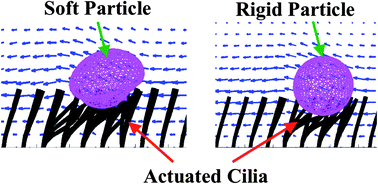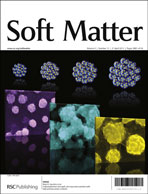Stiffness-modulated motion of soft microscopic particles over active adhesive cilia†
Abstract
Micro-scale artificial cilia have the potential to selectively manipulate particles in the surrounding fluid in unprecedented ways. Computational modeling can provide effective guidelines for optimizing the performance of these filaments for various applications in microfluidic devices. To this end, we model an array of actuated cilia that interact with compliant particles via adhesive bonds. Simulations based on the Lattice Boltzmann Method (LBM) show that the cilia are able to transport the particle in the direction of the effective stroke via a combination of fluid advection and forces due to tacky cilia–particle bonds. These simulations are performed over a range of particle stiffness and cilia–particle adhesion. For low cilia–particle adhesion, the soft particles travel faster than the rigid ones. On the other hand, for high cilia–particle adhesion strength, this trend is reversed; rigid particles travel faster than the soft ones. This stiffness-based modulation of particle speed can be explained by the larger deformation of the softer particles, leading, in turn, to a larger number of particle–cilia bonds. Our results point towards a new and robust way to separate micro-particles based on their stiffness by using active artificial cilia.


 Please wait while we load your content...
Please wait while we load your content...